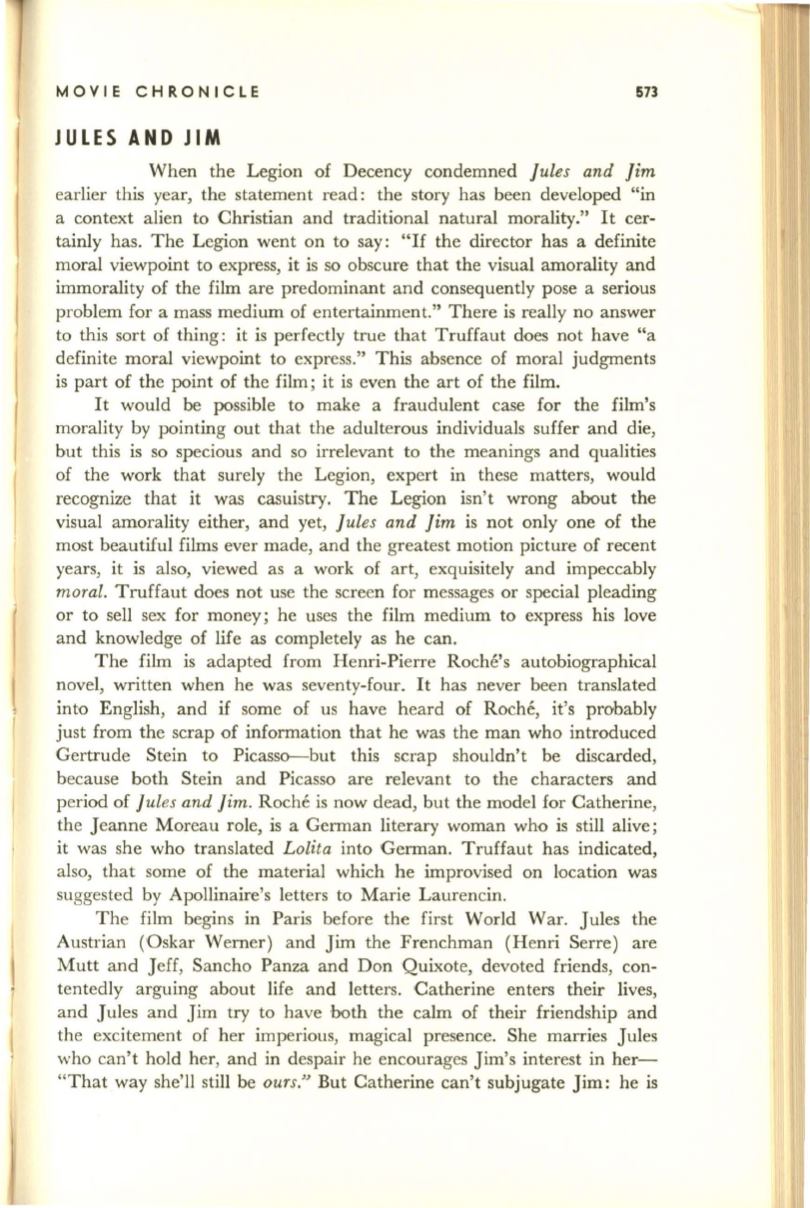
MOVIE CHRONICLE
573
JULES AND JIM
When the Legion of Decency condemned
Jules and Jim
earlier this year, the statement read: the story has been developed "in
a context alien to Christian and traditional natural morality." It cer–
tainly has. The Legion went on to say:
"If
the director has a definite
moral viewpoint to express, it is so obscure that the visual amorality and
immorality of the film are predominant and consequently pose a serious
problem for a mass medium of entertainment." There is really no answer
to this sort of thing: it is perfectly true that Truffaut does not have "a
definite moral viewpoint to express." This absence of moral judgments
is part of the point of the film; it is even the art of the film.
It would be possible to make a fraudulent case for the film's
morality by pointing out that the adulterous individuals suffer and die,
but this is so specious and so irrelevant to the meanings and qualities
of the work that surely the Legion, expert in these matters, would
recognize that it was casuistry. The Legion isn't wrong about the
visual amorality either, and yet,
Jules and Jim
is not only one of the
most beautiful films ever made, and the greatest motion picture of recent
years, it is also, viewed as a work of art, exquisitely and impeccably
moral.
Truffaut does not use the screen for messages or special pleading
or to sell sex for money; he uses the film medium to express his love
and knowledge of life as completely as he can.
The film is adapted from Henri-Pierre Roches autobiographical
novel, written when he was seventy-four. It has never been translated
into English, and if some of us have heard of Roche, it's probably
just from the scrap of information that he was the man who introduced
Gertrude Stein to Picasso-but this scrap shouldn't be discarded,
because both Stein and Picasso are relevant to the characters and
period of
Jules and Jim .
Roche is now dead, but the model for Catherine,
the Jeanne Moreau role, is a German literary woman who is still alive;
it was she who translated
Lolita
into German. Truffaut has indicated,
also, that some of the material which he improvised on location was
suggested by Apollinaire's letters to Marie Laurencin.
The film begins in Paris before the first World War. Jules the
Austrian (Oskar Werner) and Jim the Frenchman (Henri Serre) are
Mutt and Jeff, Sancho Panza and Don Quixote, devoted friends, con–
tentedly arguing about life and letters. Catherine enters their lives,
and Jules and Jim try to have -both the calm of their friendship and
the excitement of her imperious, magical presence. She marries Jules
who can't hold her, and in despair he encourages Jim's interest in her–
"That way she'll still be
ours."
But Catherine can't subjugate Jim: he is


